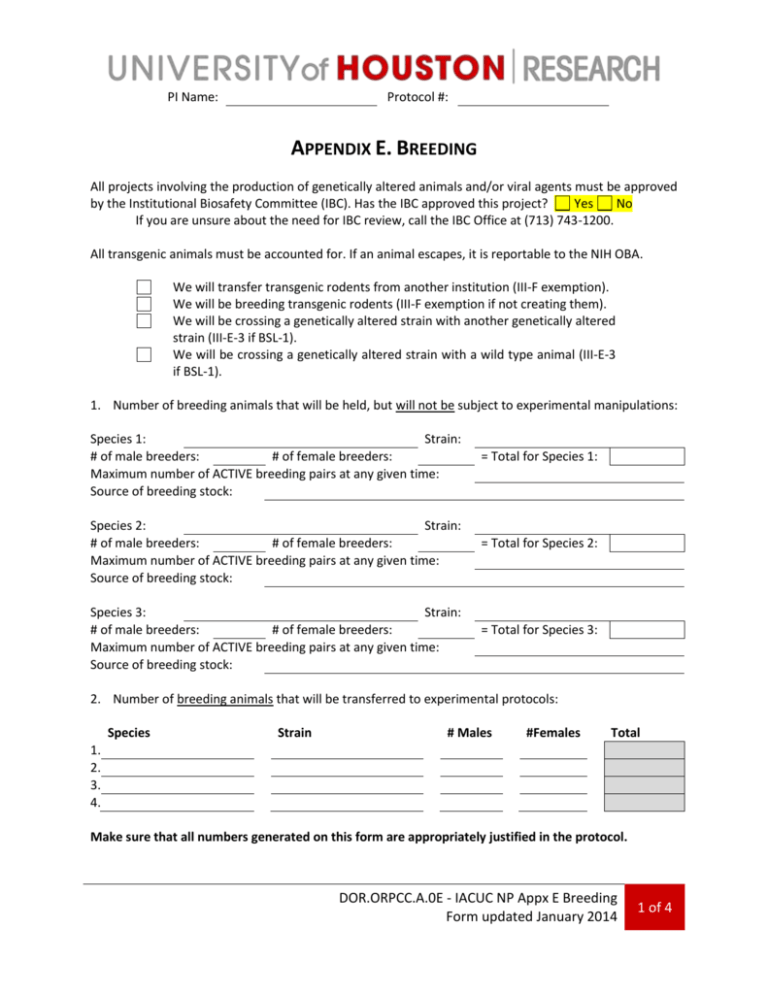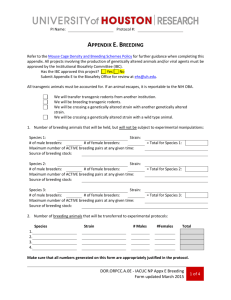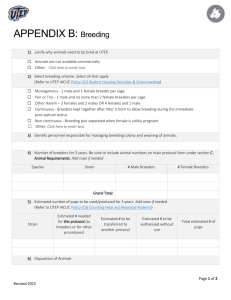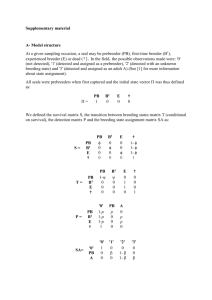DOR.ORPCC.A.0E IACUC NP Appx E Breeding
advertisement

PI Name: Protocol #: APPENDIX E. BREEDING All projects involving the production of genetically altered animals and/or viral agents must be approved by the Institutional Biosafety Committee (IBC). Has the IBC approved this project? Yes No If you are unsure about the need for IBC review, call the IBC Office at (713) 743-1200. All transgenic animals must be accounted for. If an animal escapes, it is reportable to the NIH OBA. We will transfer transgenic rodents from another institution (III-F exemption). We will be breeding transgenic rodents (III-F exemption if not creating them). We will be crossing a genetically altered strain with another genetically altered strain (III-E-3 if BSL-1). We will be crossing a genetically altered strain with a wild type animal (III-E-3 if BSL-1). 1. Number of breeding animals that will be held, but will not be subject to experimental manipulations: Species 1: Strain: # of male breeders: # of female breeders: Maximum number of ACTIVE breeding pairs at any given time: Source of breeding stock: Species 2: Strain: # of male breeders: # of female breeders: Maximum number of ACTIVE breeding pairs at any given time: Source of breeding stock: Species 3: Strain: # of male breeders: # of female breeders: Maximum number of ACTIVE breeding pairs at any given time: Source of breeding stock: = Total for Species 1: = Total for Species 2: = Total for Species 3: 2. Number of breeding animals that will be transferred to experimental protocols: Species Strain # Males #Females Total 1. 2. 3. 4. Make sure that all numbers generated on this form are appropriately justified in the protocol. DOR.ORPCC.A.0E - IACUC NP Appx E Breeding Form updated January 2014 1 of 4 3. Describe the breeding scheme and how the breeding pairs will be selected. Identify the person who will be responsible for the breeding. Mating scheme: Continuous – If continuous, how many months or years will the females be bred? Interrupted – If interrupted, how frequently will the females be bred: Maximum number of litters/births before retiring females: Disposition of retired breeders (males and females). If euthanasia, state method: Include a brief statement describing colony management. Include methods of tracking the numbers of births and disposition: 4. At what age will the offspring be weaned and who will be responsible for the weaning? (Note that if rodent boxes become overcrowded and ACO has to do the weaning, there will be a charge assessed to the PI on the per diem monthly charges invoice.) If rodents cannot be weaned at 21 days, provide an explanation. 5. In outbred strains, describe the recordkeeping and genetic management techniques employed to ensure genetic variability. In inbred or transgenic strains, describe the recordkeeping and genetic monitoring used to verify zygosity. (Note: If a skin biopsy is done, you must address ANESTHESIA/ANALGESIA and SURGERY items on the protocol.) 6. State if these animals can be replaced from vendor stock, by collaborating investigators at other institutions or if they are unique to your breeding protocol and not replaceable. 7. Describe any clinical consequences due to the phenotype of your animals (i.e. weakness at a certain age, incoordination, running in circles, hyperactivity, immunosuppression issues) 8. Include a rationale for the number of animals needed for the breeding portion of the protocol. The attached document may assist in calculating the number of animals needed to maintain the lines which you are breeding. a. Approximate total number of offspring expected to be produced: Species 1: Species 2: DOR.ORPCC.A.0E - IACUC NP Appx E Breeding Form updated January 2014 2 of 4 Species 3: Species 4: b. In the table below, estimate the number of animals in each category that will be used as subjects and transferred to experiment protocols. Weanling = The number of weaned animals (include adults) produced by this colony that will be subject to experimental manipulations. Suckling = The number of suckling animals produced by this colony that will be subject to experimental manipulations. Species Strain # Weanling to be used as subjects over 3 Years # Sucklings to be used as subjects over 3 Years Total for 3 Years 1. 2. 3. 4. c. Estimate the number of offspring produced by this colony that will be euthanized and which will not be subject to experimental manipulations. Species Strain # Weanling to be used as subjects over 3 Years # Sucklings to be used as subjects over 3 Years Total for 3 Years 1. 2. 3. 4. d. Explain the how the(se) number(s) was/were determined and justify. Include culling for sex selection or to achieve standardized litter size. Species Strain Totals From 3.A Totals From 3.B Totals From 4.C Totals From 4.D = Total Animals 1. 2. 3. 4. For rodent breeders: In order to be able to document the number of animals produced in this protocol, the investigator must maintain a log of the number of offspring weaned during any one month. The DOR.ORPCC.A.0E - IACUC NP Appx E Breeding Form updated January 2014 3 of 4 Monthly Log of Rodents Produced is available from the ACO Office (SR II Room 10). The completed monthly form should be submitted to ACO by the second week of the following month. Alternatively, yellow litter cards may be filled in at the time of the birth and turned over to ACO after weaning to document numbers. Be sure to fill in all information requested. If animals are used in a research project before weaning occurs, list numbers of live post-natal mice used in the protocol. If pre-natal embryos are used in a protocol, list the number of embryos used. DOR.ORPCC.A.0E - IACUC NP Appx E Breeding Form updated January 2014 4 of 4







